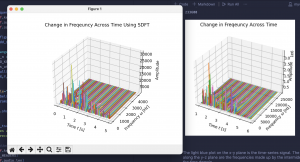This week, we revisited our rescoped project and laid out the plans amongst ourselves and the professors. In last week’s team status report, we went on a deep dive of our new scope (linked here for reference: Last Week’s Report).
In terms of current progress in our overall project, we have focused efforts on rounding out playing back the processed audio using virtual piano notes through our web app. For the audio processing component, the system successfully implements a Sliding Discrete Fourier Transform to be able to capture amplitudes from the input audio at each specific piano frequency. This has allowed for accurate reconstruction of the audio using just the frequencies at each piano key. Below we have graphs showing the comparison of the reconstructed audio (left) and the original (right) in the above image. If the image quality permits, you can see how, by only using the piano keys, we are able to create a very similar Time vs. Frequency vs. Amplitude graph.

In this graph we have processed an audio file of just 1 piano key. We can see based on our audio processing the spike at the frequency of that key and the corresponding spectrogram showing the brightest color for that frequency. This was done as a way to prove that our processing is accurately capturing values for the input frequency and a bit of a sanity check.

For the Web app and note scheduling, we have been discussing the idea of incorporating the natural decay of piano keys to determine how we will determine whether a note will be re-pressed at any given sample and how we can playback the audio at different volumes using our web app. We have acquired audio files for every note, and using the 2-D array from the scheduler representing which of the 69 keys to play at each sample, we will be playing the corresponding audio file to recreate all the notes played at each sample.
This upcoming week, we are planning to take measurements of note accuracy, fidelity with understanding speech through the audio playback, and performing an inverse FFT on the audio (not using the piano note audio files as a medium) to compare the recreation using piano notes. As we wrap up our project, we are also preparing our presentation, final paper, and fine-tuning our performance metrics to meet the requirements we set for ourselves.
